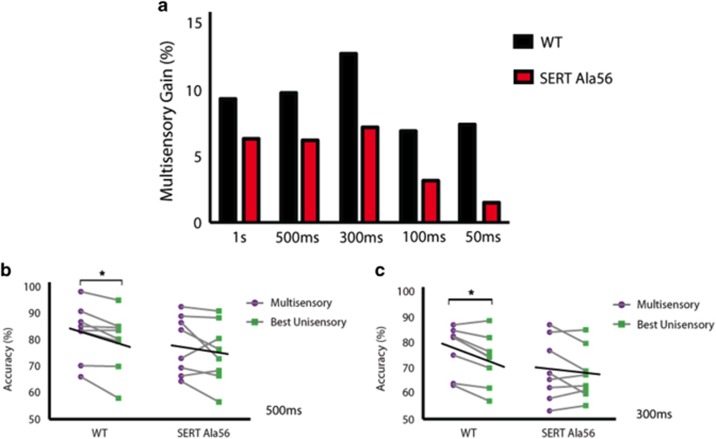Figure 4.
Evaluating multisensory gain across stimulus durations at both the group and individual performance levels. Wild-type animals demonstrated greater multisensory gain than SERT Ala56 animals at the group level at all stimulus durations (a). The values for multisensory gain for wild-type mice were as follows: 1 s—9.30%, 500 ms—9.74%, 300 ms—12.70%, 100 ms—6.90% and 50 ms—7.40%. Multisensory gain values for SERT Ala56 mice were as follows: 1 s—6.30%, 500 ms—6.20%, 300 ms—7.20%, 100 ms—3.14% and 50 ms—1.50%. Significant differences in accuracies under multisensory and the best unisensory conditions were observed at both the 500 ms (b) and 300 ms (c) stimulus durations for wild-type animals. At the 300 ms duration, a repeated measures two-way ANOVA demonstrated a significant main effect of sensory modality (P=0.0334; F(1, 7)=6.969) and a significant main effect of genotype (P=0.0421; F(1, 7)=6.159; c). Significant differences between multisensory and the best unisensory conditions were observed for wild-type mice (P=0.02) but not SERT Ala56 mice (P=0.36). No significant differences in behavioral accuracies were observed for SERT Ala56 mice for either the 500 ms (b) or 300 ms (c) stimulus duration. Black lines represent the group average performance under multisensory and the best unisensory conditions. Note the descending slope of these lines, which is apparent for wild-type animals at the 500 and 300 ms durations and is not observed for SERT Ala56 mice. The significant level is: (*P<0.05). ANOVA, analysis of variance; SERT, serotonin transporter; WT, wild-type.

